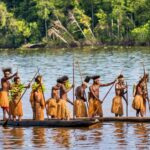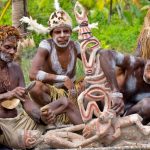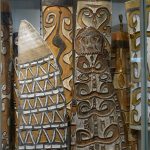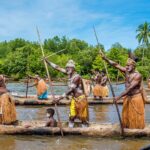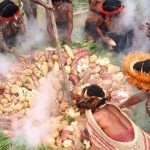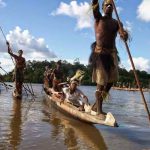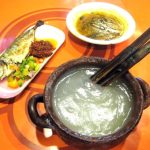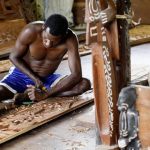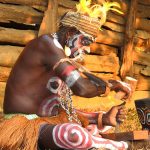Asmat
Asmat
The Asmat tribe is a tribe in South Papua. The Asmat tribe is known for its unique wood carvings. The population of the Asmat tribe is divided into two, namely those who live on the coast and those who live in the interior. These two populations differ from each other in terms of dialect, way of life, social structure and rituals. The coastal population is then divided into two parts, namely the Bisman tribe which is between the Sinesty River, and the Simai tribe which is in the Nin River.
The Asmat tribe is known for its very distinctive traditional wood carvings. Some of the ornaments/motifs that are often used and become the main theme in the process of sculpting statues by the Asmat people are taking the theme of their tribal ancestors, commonly called mbis. But it doesn’t stop there, they often find other ornaments/motifs resembling boats or wuramon, which they believe are symbols of spirit boats that carry their ancestors to the realm of the dead. For the indigenous people of the Asmat tribe, woodcarving is more of an embodiment of their way of performing rituals to commemorate the spirits of their ancestors.
Asmat people generally have distinctive physical characteristics, black skin and curly hair. His body is quite tall. The average height of the female Asmat is around 162 cm and the height of the male reaches 172 cm.
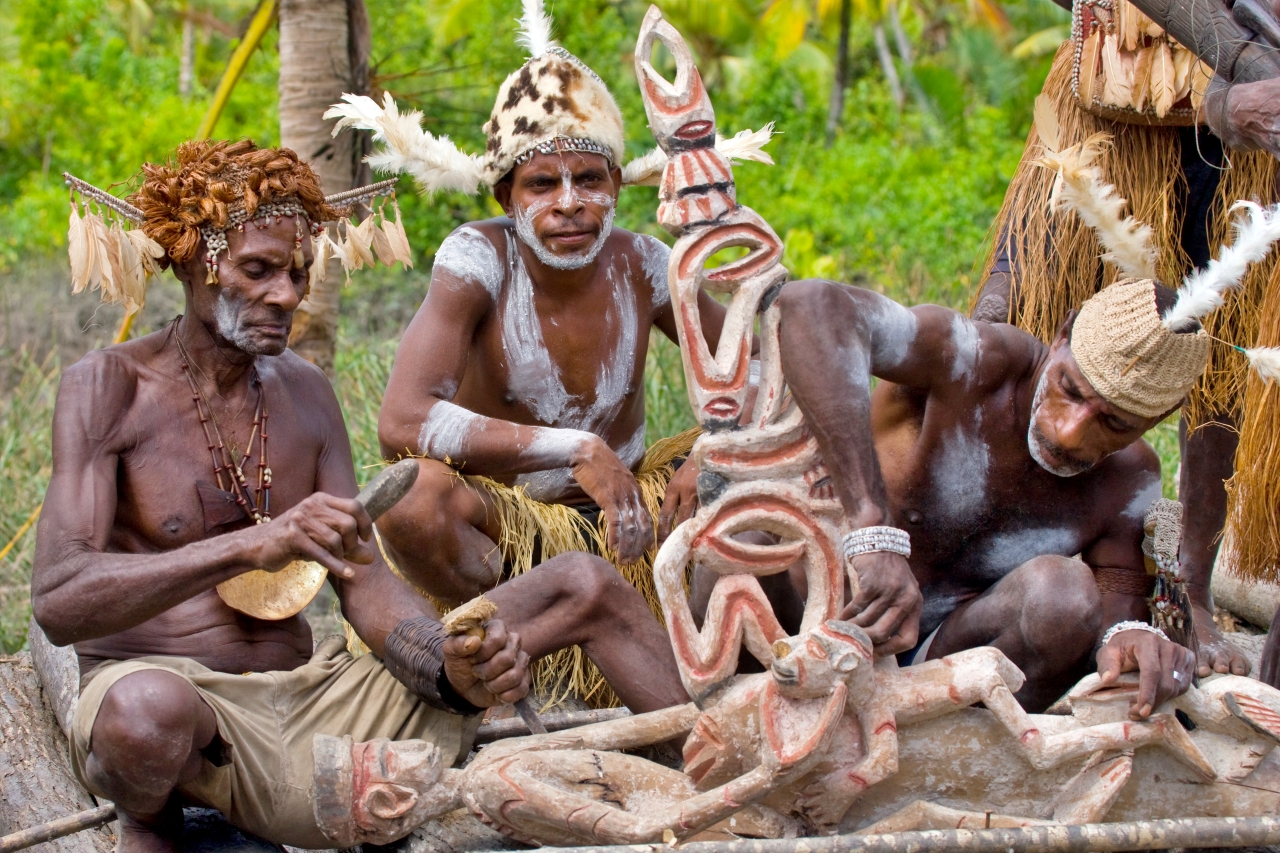 Natural Conditions
The area occupied by the Asmat is a soft brown plain covered by river spider webs. The area inhabited by the Asmat Tribe has become its own Regency with the name Asmat Regency with 7 Districts or Districts. It rains almost every day with a rainfall of 3000-4000 mm/year. Every day the sea tides enter this area, so it is not surprising that the ground surface is very soft and muddy. The path was made only of wooden planks piled on soft ground. Practically not all motorized vehicles can pass through this road. People walking should be careful not to slip, especially when it’s raining.
Natural Conditions
The area occupied by the Asmat is a soft brown plain covered by river spider webs. The area inhabited by the Asmat Tribe has become its own Regency with the name Asmat Regency with 7 Districts or Districts. It rains almost every day with a rainfall of 3000-4000 mm/year. Every day the sea tides enter this area, so it is not surprising that the ground surface is very soft and muddy. The path was made only of wooden planks piled on soft ground. Practically not all motorized vehicles can pass through this road. People walking should be careful not to slip, especially when it’s raining.
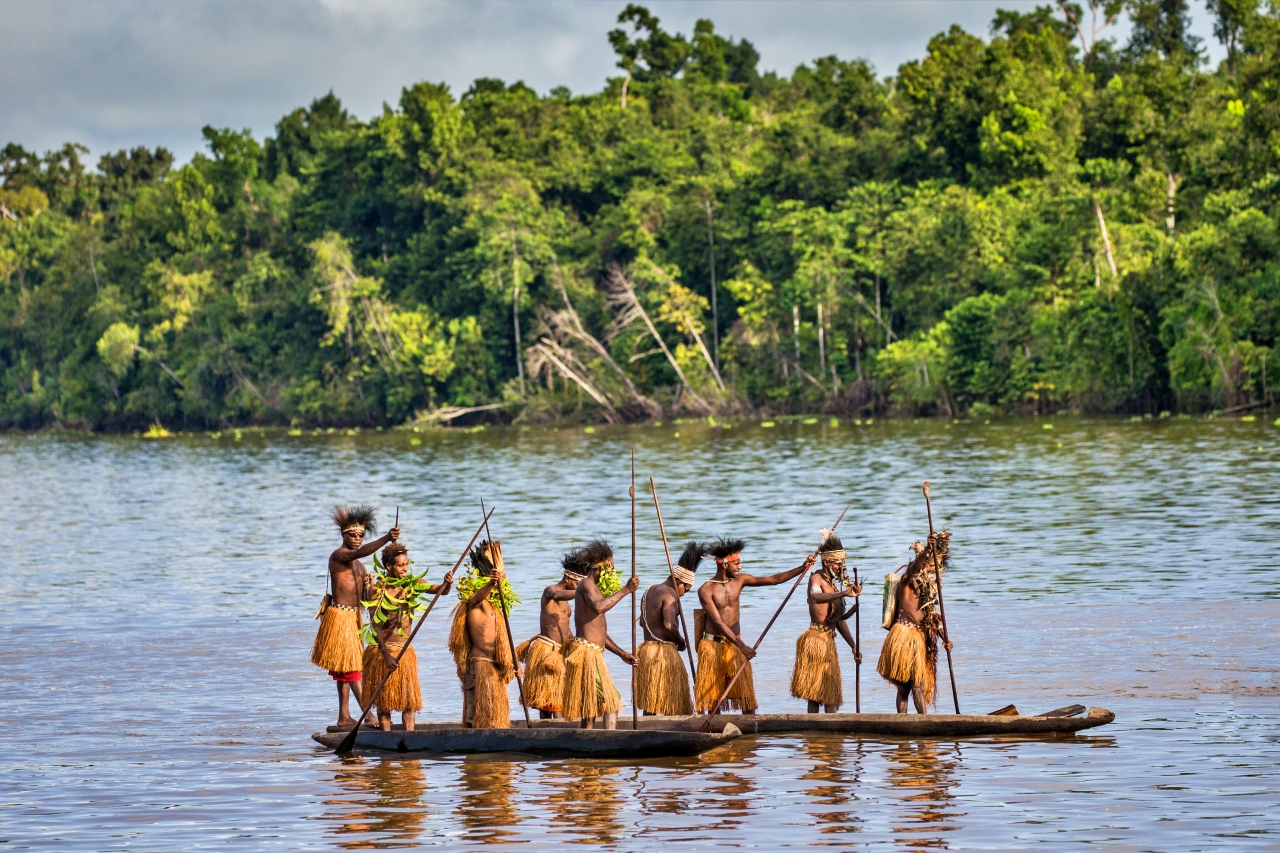 Spread
The Asmat tribe is scattered and inhabits the area around the coast of the Arafuru Sea and the Jayawijaya Mountains, with a fairly tough terrain considering the area they occupy is wilderness, in the life of the Asmat tribe, the stones that we usually see on the streets are very valuable to them. In fact, the stones can be used as a dowry. All of this is because the Asmat tribe lives in swamps, so it is very difficult to find street stones which are very useful for them to make axes, hammers, and so on.
Spread
The Asmat tribe is scattered and inhabits the area around the coast of the Arafuru Sea and the Jayawijaya Mountains, with a fairly tough terrain considering the area they occupy is wilderness, in the life of the Asmat tribe, the stones that we usually see on the streets are very valuable to them. In fact, the stones can be used as a dowry. All of this is because the Asmat tribe lives in swamps, so it is very difficult to find street stones which are very useful for them to make axes, hammers, and so on.
Asmat Village Currently, approximately 100 to 1000 people live in one village. Each village has one Bujang house and many family houses. The Bujang house is used for traditional ceremonies and religious ceremonies. Family homes are inhabited by two to three families, which have their own bathroom and kitchen. Today, there are approximately 70,000 Asmat people living in Indonesia. The majority of Asmat children are in school.
 Natural Conditions
The area occupied by the Asmat is a soft brown plain covered by river spider webs. The area inhabited by the Asmat Tribe has become its own Regency with the name Asmat Regency with 7 Districts or Districts. It rains almost every day with a rainfall of 3000-4000 mm/year. Every day the sea tides enter this area, so it is not surprising that the ground surface is very soft and muddy. The path was made only of wooden planks piled on soft ground. Practically not all motorized vehicles can pass through this road. People walking should be careful not to slip, especially when it’s raining.
Natural Conditions
The area occupied by the Asmat is a soft brown plain covered by river spider webs. The area inhabited by the Asmat Tribe has become its own Regency with the name Asmat Regency with 7 Districts or Districts. It rains almost every day with a rainfall of 3000-4000 mm/year. Every day the sea tides enter this area, so it is not surprising that the ground surface is very soft and muddy. The path was made only of wooden planks piled on soft ground. Practically not all motorized vehicles can pass through this road. People walking should be careful not to slip, especially when it’s raining.
 Spread
The Asmat tribe is scattered and inhabits the area around the coast of the Arafuru Sea and the Jayawijaya Mountains, with a fairly tough terrain considering the area they occupy is wilderness, in the life of the Asmat tribe, the stones that we usually see on the streets are very valuable to them. In fact, the stones can be used as a dowry. All of this is because the Asmat tribe lives in swamps, so it is very difficult to find street stones which are very useful for them to make axes, hammers, and so on.
Spread
The Asmat tribe is scattered and inhabits the area around the coast of the Arafuru Sea and the Jayawijaya Mountains, with a fairly tough terrain considering the area they occupy is wilderness, in the life of the Asmat tribe, the stones that we usually see on the streets are very valuable to them. In fact, the stones can be used as a dowry. All of this is because the Asmat tribe lives in swamps, so it is very difficult to find street stones which are very useful for them to make axes, hammers, and so on.
Asmat Village Currently, approximately 100 to 1000 people live in one village. Each village has one Bujang house and many family houses. The Bujang house is used for traditional ceremonies and religious ceremonies. Family homes are inhabited by two to three families, which have their own bathroom and kitchen. Today, there are approximately 70,000 Asmat people living in Indonesia. The majority of Asmat children are in school.
 Livelihoods
The habits of survival and foraging between one tribe and another in the Citak-Mitak District turned out to be almost the same. The Asmat Darat, Citak and Mitak tribes have a daily habit of hunting forest animals such as snakes, cassowaries, birds, wild boar, and so on. They also always mix/smoke sago as a staple food. The fishermen look for fish and shrimp to eat. The life of these three tribes has changed.
Livelihoods
The habits of survival and foraging between one tribe and another in the Citak-Mitak District turned out to be almost the same. The Asmat Darat, Citak and Mitak tribes have a daily habit of hunting forest animals such as snakes, cassowaries, birds, wild boar, and so on. They also always mix/smoke sago as a staple food. The fishermen look for fish and shrimp to eat. The life of these three tribes has changed.
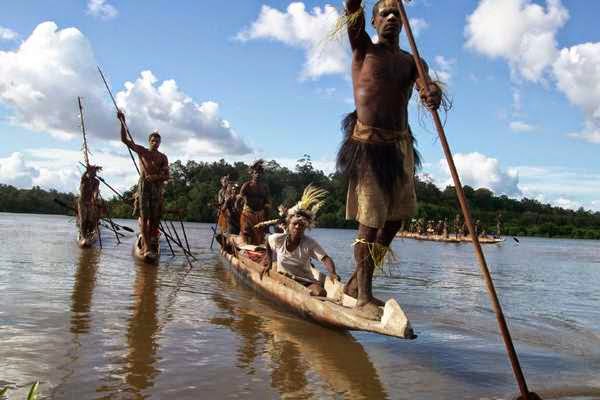 Everyday Asmat people work in their surroundings, especially to find food, by hunting or gardening, using quite traditional and still simple methods. The Asmat tribe’s cuisine is not like ours. A special dish for them is sago worms. However, their daily life is only grilling fish or animal meat that they have hunted.
In the life of the Asmat tribe, the “stones” that we usually see on the streets are very valuable. In fact, the stones can be used as a dowry. All of this is because the Asmat tribe’s residence forms swamps, so it is very difficult to find street stones that are useful for them to make axes, hammers, and so on.
Everyday Asmat people work in their surroundings, especially to find food, by hunting or gardening, using quite traditional and still simple methods. The Asmat tribe’s cuisine is not like ours. A special dish for them is sago worms. However, their daily life is only grilling fish or animal meat that they have hunted.
In the life of the Asmat tribe, the “stones” that we usually see on the streets are very valuable. In fact, the stones can be used as a dowry. All of this is because the Asmat tribe’s residence forms swamps, so it is very difficult to find street stones that are useful for them to make axes, hammers, and so on.
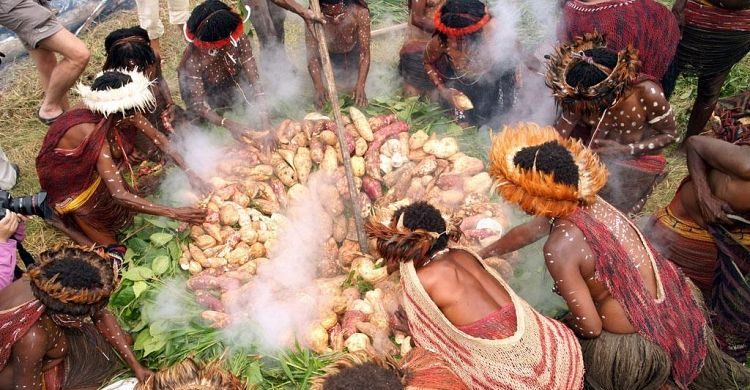 Staple food
The staple food of the Asmat people is sago. Almost every day they eat sago which is made into balls which are baked in hot coals. Another hobby is eating sago caterpillars that live on sago tree trunks. Sago caterpillars are usually wrapped in nipa leaves, sprinkled with sago, and roasted in hot coals.
In addition, vegetables and grilled fish serve as a complement. But what is concerning is the problem of clean water sources. Groundwater is difficult to obtain because their area is swampy land. They are forced to use rainwater and swamp water as clean water for their daily needs.
Staple food
The staple food of the Asmat people is sago. Almost every day they eat sago which is made into balls which are baked in hot coals. Another hobby is eating sago caterpillars that live on sago tree trunks. Sago caterpillars are usually wrapped in nipa leaves, sprinkled with sago, and roasted in hot coals.
In addition, vegetables and grilled fish serve as a complement. But what is concerning is the problem of clean water sources. Groundwater is difficult to obtain because their area is swampy land. They are forced to use rainwater and swamp water as clean water for their daily needs. (km2) Main Area living
0
(Thousand) Population
0
 Life Pattern
One thing that should be emulated from the lifestyle of the indigenous Asmat people is that they feel themselves as part of nature. Therefore, they really respect and protect the environment. In fact, the trees around where they live are considered to be a picture of themselves. The trunk represents the hands, the fruit represents the head, and the roots represent their feet.
Life Pattern
One thing that should be emulated from the lifestyle of the indigenous Asmat people is that they feel themselves as part of nature. Therefore, they really respect and protect the environment. In fact, the trees around where they live are considered to be a picture of themselves. The trunk represents the hands, the fruit represents the head, and the roots represent their feet.
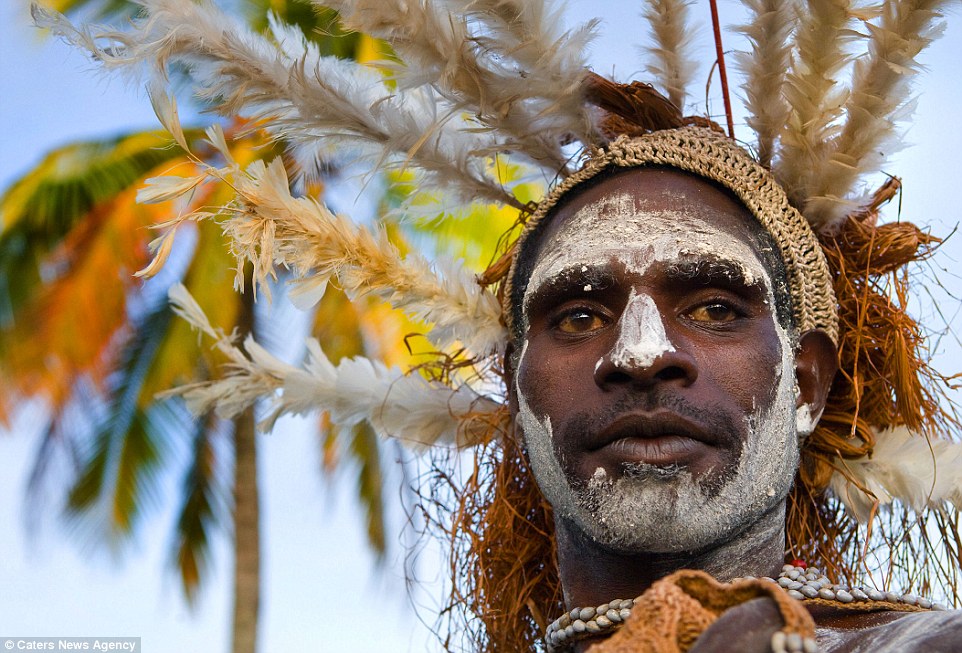 Make Up
The Asmat tribe has a very simple way to make up themselves. They only need red soil to produce red. To produce a white color they make it from crushed shells. While the black color comes from crushed wood charcoal. How to use it is quite simple, just by mixing the material with a little water, the dye can already be used to color the body.
Make Up
The Asmat tribe has a very simple way to make up themselves. They only need red soil to produce red. To produce a white color they make it from crushed shells. While the black color comes from crushed wood charcoal. How to use it is quite simple, just by mixing the material with a little water, the dye can already be used to color the body.
Customs The Asmat tribe is a tribe that adheres to Animism, until the arrival of the Missionaries who brought new teachings, they began to recognize religions other than the religion of their ancestors. Now, the Asmat people have embraced various religions, such as Protestantism, Catholicism and Islam. Like society in general, in carrying out their life processes, the Asmat people also go through various processes, namely:
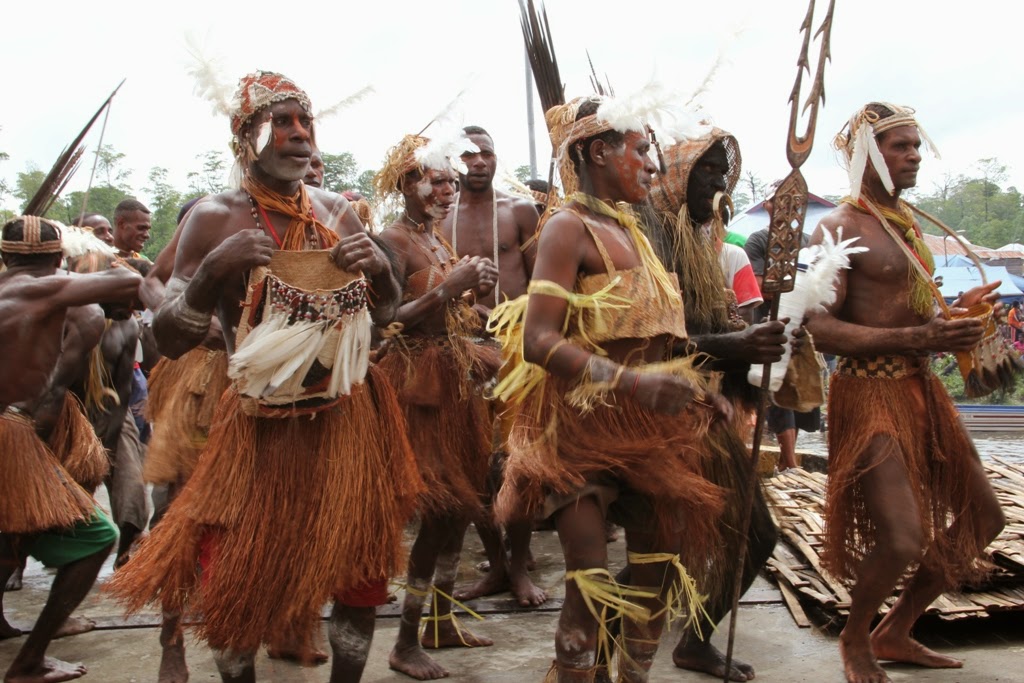
- Pregnancy, during this process, future generations are well looked after so that they can be born safely with the help of their biological mother or mother-in-law.
- The birth, not long after the baby was born, a simple salvation ceremony was carried out by cutting the umbilical cord using a knife, a tool made of stretched bamboo. Furthermore, given ASI until the age of 2 years or 3 years.
- Marriage, this process applies to both men and women who are 17 years old, is carried out by the male’s parents after both parties reach an agreement and go through a test of courage to buy a woman with her dowry in the form of an antique plate based on the value of money agreed on Johnson’s boat, if there is a deficiency in the interpretation of the price of Johnson’s boat, so the man is obliged to pay it off and during the settlement period the man is prohibited from committing acts of violence even though he is allowed to live under one roof.
- Death, when a tribal chief or customary head dies, his body is kept in a mummified form and displayed in front of the joglo of this tribe, while for the general public their bodies are buried. This process is carried out with the accompaniment of singing in the Asmat language and cutting the knuckles of the fingers of the family members left behind.
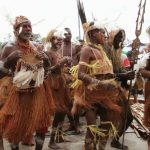
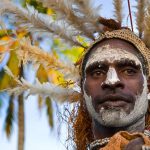

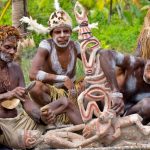
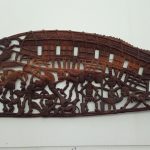

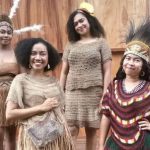
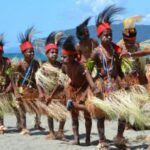
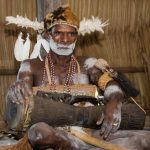
 Mythology
In terms of confidence, the Asmat people believe that they are the descendants of the gods coming down from the unseen world which is across the ocean behind the horizon, where the sun sets every day. According to the Asmat people’s beliefs, the god of the ancestors first landed on Earth in a place far away in the mountains. On his way downstream until he arrived at a place now inhabited by the downstream Asmat people, he experienced many adventures.
Mythology
In terms of confidence, the Asmat people believe that they are the descendants of the gods coming down from the unseen world which is across the ocean behind the horizon, where the sun sets every day. According to the Asmat people’s beliefs, the god of the ancestors first landed on Earth in a place far away in the mountains. On his way downstream until he arrived at a place now inhabited by the downstream Asmat people, he experienced many adventures.
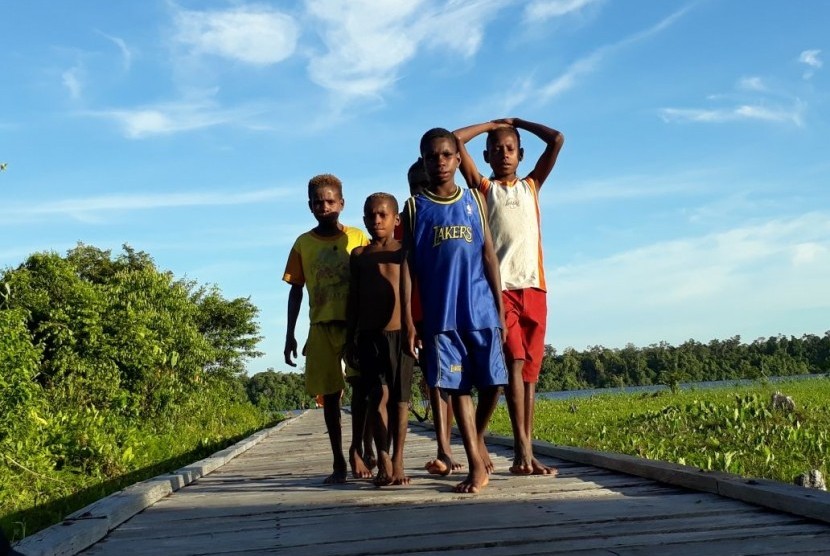 In the mythology of the Asmat people who live in Flamingo Bay, for example, the god’s name is Fumeripitsy. When he walked from the headwaters to the sea, he was attacked by a giant crocodile. The mortar boat he was on sank. In the fierce fighting that happened, he could kill the crocodile, but he was gravely injured. He was carried away by the current, which beached him on the bank of the Asewetsy river, now Syuru Village.
Luckily there was a Flamingo to nurse him back to health; then he built a yew house and carved two very beautiful statues and made an Em drum, which sounded very loud. After he finished, he began to dance continuously without stopping, and the sacred power that was released from his movements gave life to the two statues he had carved. Not long after, the statues began to move and dance, and they later became the first human pair, namely the ancestors of the Asmat people.
In the mythology of the Asmat people who live in Flamingo Bay, for example, the god’s name is Fumeripitsy. When he walked from the headwaters to the sea, he was attacked by a giant crocodile. The mortar boat he was on sank. In the fierce fighting that happened, he could kill the crocodile, but he was gravely injured. He was carried away by the current, which beached him on the bank of the Asewetsy river, now Syuru Village.
Luckily there was a Flamingo to nurse him back to health; then he built a yew house and carved two very beautiful statues and made an Em drum, which sounded very loud. After he finished, he began to dance continuously without stopping, and the sacred power that was released from his movements gave life to the two statues he had carved. Not long after, the statues began to move and dance, and they later became the first human pair, namely the ancestors of the Asmat people.

